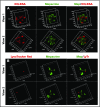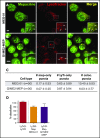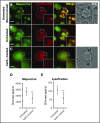Platelet dense granules begin to selectively accumulate mepacrine during proplatelet formation
- PMID: 28936487
- PMCID: PMC5604861
- DOI: 10.1182/bloodadvances.2017006726
Platelet dense granules begin to selectively accumulate mepacrine during proplatelet formation
Abstract
Platelet dense granules (DGs) are storage organelles for calcium ions, small organic molecules such as ADP and serotonin, and larger polyphosphates that are secreted upon platelet stimulation to enhance platelet activation, adhesion, and stabilization at sites of vascular damage. DGs are thought to fully mature within megakaryocytes (MKs) prior to platelet formation. Here we challenge this notion by exploiting vital fluorescent dyes to distinguish mildly acidic DGs from highly acidic compartments by microscopy in platelets and MKs. In isolated primary mouse platelets, compartments labeled by mepacrine - a fluorescent weak base that accumulates in DGs - are readily distinguishable from highly acidic compartments, likely lysosomes, that are labeled by the acidic pH indicator, LysoTracker, and from endolysosomes and alpha granules labeled by internalized and partially digested DQ™ BSA. By contrast, in murine fetal liver- and human CD34+ cell-derived MKs and the megakaryocytoid cell lines, MEG-01 and differentiated G1ME2, labeling by mepacrine overlapped nearly completely with labeling by LysoTracker and partially with labeling by DQ™ BSA. Mepacrine labeling in G1ME2-derived MKs was fully sensitive to proton ATPase inhibitors, but was only partially sensitive in platelets. These data indicate that mepacrine in MKs accumulates as a weak base in endolysosomes but is likely pumped into or retained in separate DGs in platelets. Fluorescent puncta that labeled uniquely for mepacrine were first evident in G1ME2-derived proplatelets, suggesting that DGs undergo a maturation step that initiates in the final stages of MK differentiation.
Keywords: dense granule; live cell imaging; lysosome; lysosome-related organelle; megakaryocyte; platelets; proplatelet.
Conflict of interest statement
DISCLOSURE OF CONFLICTS OF INTEREST The authors declare no competing financial interests.
Figures








Similar articles
-
Regulation of actin polymerization by tropomodulin-3 controls megakaryocyte actin organization and platelet biogenesis.Blood. 2015 Jul 23;126(4):520-30. doi: 10.1182/blood-2014-09-601484. Epub 2015 May 11. Blood. 2015. PMID: 25964668 Free PMC article.
-
Storage pool diseases illuminate platelet dense granule biogenesis.Platelets. 2017 Mar;28(2):138-146. doi: 10.1080/09537104.2016.1243789. Epub 2016 Nov 16. Platelets. 2017. PMID: 27849413 Free PMC article. Review.
-
A flow cytometric assay using mepacrine for study of uptake and release of platelet dense granule contents.Br J Haematol. 1995 Feb;89(2):380-5. doi: 10.1111/j.1365-2141.1995.tb03315.x. Br J Haematol. 1995. PMID: 7873389
-
Vps34 derived phosphatidylinositol 3-monophosphate modulates megakaryocyte maturation and proplatelet production through late endosomes/lysosomes.J Thromb Haemost. 2020 Jul;18(7):1756-1772. doi: 10.1111/jth.14764. Epub 2020 Mar 17. J Thromb Haemost. 2020. PMID: 32056354
-
Mechanics of proplatelet elaboration.J Thromb Haemost. 2007 Jul;5 Suppl 1:18-23. doi: 10.1111/j.1538-7836.2007.02487.x. J Thromb Haemost. 2007. PMID: 17635704 Review.
Cited by
-
Integrated microfluidic multiple electrode aggregometry for point-of-care platelet function analysis.Lab Chip. 2024 Oct 9;24(20):4859-4868. doi: 10.1039/d4lc00469h. Lab Chip. 2024. PMID: 39291871
-
Thrombocytopenia after meta-iodobenzylguanidine (MIBG) therapy in neuroblastoma patients may be caused by selective MIBG uptake via the serotonin transporter located on megakaryocytes.EJNMMI Res. 2021 Aug 23;11(1):81. doi: 10.1186/s13550-021-00823-5. EJNMMI Res. 2021. PMID: 34424429 Free PMC article.
-
A zinc transporter, transmembrane protein 163, is critical for the biogenesis of platelet dense granules.Blood. 2021 Apr 1;137(13):1804-1817. doi: 10.1182/blood.2020007389. Blood. 2021. PMID: 33513603 Free PMC article.
-
Metabolic signatures of cardiorenal dysfunction in plasma from sickle cell patients as a function of therapeutic transfusion and hydroxyurea treatment.Haematologica. 2023 Dec 1;108(12):3418-3432. doi: 10.3324/haematol.2023.283288. Haematologica. 2023. PMID: 37439373 Free PMC article.
-
CRISPR-edited megakaryocytes for rapid screening of platelet gene functions.Blood Adv. 2021 May 11;5(9):2362-2374. doi: 10.1182/bloodadvances.2020004112. Blood Adv. 2021. PMID: 33944898 Free PMC article.
References
-
- Heijnen H, van der Sluijs P. Platelet secretory behaviour: as diverse as the granules … or not? J Thromb Haemost. 2015;13(12):2141-2151. - PubMed
-
- Wei AH, Li W. Hermansky-Pudlak syndrome: pigmentary and non-pigmentary defects and their pathogenesis. Pigment Cell Melanoma Res. 2013;26(2):176-192. - PubMed
-
- Nurden A, Nurden P. Advances in our understanding of the molecular basis of disorders of platelet function. J Thromb Haemost. 2011;9(Suppl 1):76-91. - PubMed
-
- Seward SL Jr, Gahl WA. Hermansky-Pudlak syndrome: health care throughout life. Pediatrics. 2013;132(1):153-160. - PubMed
Grants and funding
LinkOut - more resources
Full Text Sources
Other Literature Sources

